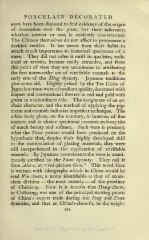Page 235 - Oriental Series Japan and China, Brinkly
P. 235
PORCELAIN DECORATED
seurs have been disposed to find evidence of the origin
of decoration over the glaze, but their inference,
whether correct or not, is evidently unwarranted.
The Chinese themselves do not affect to pronounce a
decided verdict. It has never been their habit to
attach much importance to historical specimens of a
ware. They did not value it until its qualities, tech-
nical or artistic, became really attractive, and from
this point of view they are unanimous in attributing
the first noteworthy use of vitrifiable enamels to the
early eras of the Ming dynasty. Japanese traditions
give some aid. Highly prized by the Tea Clubs of
Japan is a stone-ware of medium quality, decorated with
diapers and conventional flowers in red and gold with
green in a subordinate role. The designs are of an ar-
chaic character, and the method of applying the pig-
ments and enamels indicates imperfect technique. The
white body-glaze, on the contrary, is lustrous, of fine
texture, and in choice specimens possesses an ivory tint
of much beauty and softness. Such ware is precisely
what the Yuan potters would have produced on the
hypothesis that, despite their highly developed skill
in the manipulation of glazing materials, they were
still inexperienced in the application of vitrifiable
enamels. By Japanese connoisseurs the ware is unani-
mously ascribed to the Yuan dynasty. They call it
"
Gosu Aka-e or Gosu." This word Gosu
y red-picture
is written with ideographs which in China would be
read Wu-shuan, a name identifiable as that of an an-
cient division the most easterly of the province
of Chekiang. Now it is known that Hang-chow,
in Chekiang, was one of the principal starting points
of China's export trade during the Sung and Yuan
dynasties, and that at Ch'iiah-chou-fu, in the neigh-
181

